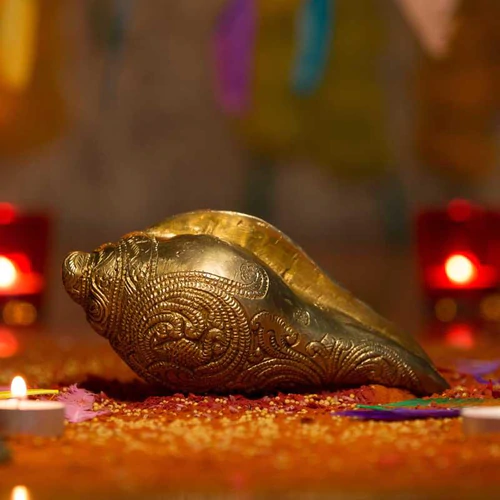
A conch or Shankh is deeply rooted in Hinduism. It is believed that the sound of sacred Om, which is known to be the first sound of creation, is associated with the sound of the conch. It is a pious article and is used in all religious rituals.
Shankh and its Importance
Shankh is used in religious rites to signal the start of a prayer or the advent of a deity. Sacred water is gathered and distributed in it in various places. Shankha is blown at the start of every festival and auspicious beginning, and its sound welcomes in new life and optimism. Water is frequently collected and kept in the conch shell, which is then sprinkled during pujas.
The conch shell is filled with milk before being poured over the idol during Lakshmi Puja. While worshipping the sun, water gathered in Shankh is presented. When sacred shankh is blown during religious events, the thunderous musical notes rent the air, allowing fervent feelings to be expressed.
Shankh is also a part of Indian classical music, and there is a mudra based on it in classical dance. The blowing of shankh cleanses and purifies the air, making it favourable to spiritual meditation. As a result, receiving the highest sattvik frequencies from the deities becomes more easy.
Know about Indian Mythology and Shankh
Due to Durvasa Rishi’s curse, Devaraja Indra had to suffer, whereas Daityaraj Bali had conquered the three planets. Bali wreaked mayhem all over the place. All the gods came to Lord Vishnu to find a solution to Bali’s problem. He advised all of the Gods to participate in the Samudra Manthan. The devils and Gods then joined forces to churn the seas in order to capture Amrit.
With Samudra Manthan, a total of fourteen diamonds were released. One of them was Conch Shell. Lord Vishnu was honoured with this conch. That is why the conch is played so prominently during the Lakshmi-Vishnu Puja.
Panchajanya Shankh was the name given to Lord Vishnu’s conch. It is the most powerful shankh of all. Panchajanya Shankh is associated with prosperity, peace, money, and material success. This conch, together with the Sudarshan Chakra and Lotus flower, are essential parts of Vishnu’s idol.
What are the types of Shankh?
Shankh is divided into several categories, each of which is named after a God. There are also Right-Handed and Left-Handed shankhs, which belong to Vishnu and Shiva, respectively. Ganesh Shankh, Dakshinavarti Shankh, Vamavarti Shankh, Kauri Shankh, Gaumukhi Shankh, Shankhini, Heera Shankh, and Moti Shankh are all based on the names of Gods.
Some other Conchs are:
Panchjanya — the conch shell of Lord Sri Krishna.
Anantavijaya — name of King Yudhisthira’s conch shell
Paundra — the terrific conchshell of Bhima.
Devadatta — the conch of Arjuna
Manipuspaka — name of Sahadeva’s conch-shell
Sughosa — the conch shell of Nakula
Other than its spiritual and mythological significance, one should know the health benefits and what is conch good for.
Drinking the water held overnight in the conch cures several maladies such as jaundice, bones, teeth, and stomach problems. Calcium, Phosphorus, Magnesium, and Sulphur are all present. Blowing the conch produces scalar sound waves that help to balance the chakras in the body.
The vibrations it generates clean the air and are said to kill disease-causing microorganisms in the atmosphere. It aids in the development of excellent lung capacity. The thyroid, neck muscles, and vocal cords are all affected by blowing the Conch.
Anything with spiritual importance should be carefully cared for according to rituals and conventions. Shankh is no different. A shankh may appear insignificant, but it is a powerful healer. It is suitable for keeping at home since it brings positive energy and good fortune. Inquire with our specialist about the best conch for you.
